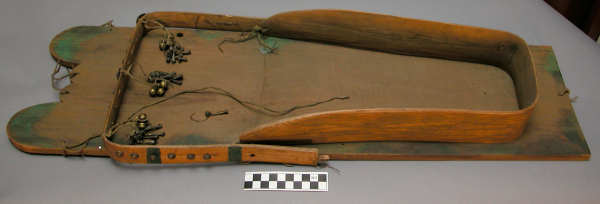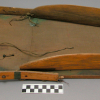cradleboard
cradleboard
cradleboard


The cradleboard is flat and firm. It has a wooden handle and footrest. Tiny brass bells are attached to the handlebar, and the green pigment is painted on the wooden plank.
Peabody Museum’s data.
Read More About This Relative
Wood, Metal, Paint
The artists processed the tree for the wood, then he or she carved a design on the board and bowed the handlebar.
Traditionally, the cradleboard served multiple purposes. Its primary purpose was to safely carry the baby on the mother’s back while she worked or moved from one camp to another. Both mother and baby would accompany each other while harvesting berries and medicine. The baby was laced into the cradleboard under a protective covering. This protected the baby from the underbrush and insects. Its secondary purpose was childcare. The cradleboard was used to keep the baby near the mother and was usually placed against the trunk of a tree or hung from a branch. From this vantage point the baby could watch the mother, the environment, social interactions and the animals. The cradleboard is constructed with a crash bar. This handlebar protects the baby from falls. A third benefit was how the cradleboard kept the baby’s back and legs straight.
Many Indigenous people are reviving the cradleboard back into their communities to enrich the infant’s senses and health.
Museum Purchase, Huntington Frothingham Wolcott Fund, 1905. Image © President and Fellows of Harvard College, Peabody Museum of Archaeology and Ethnology, 05-34-10/65403
Dealer: Fred Harvey. Peabody Museum’s data.
Provenance
Museum Purchase, Huntington Frothingham Wolcott Fund, 1905. Image © President and Fellows of Harvard College, Peabody Museum of Archaeology and Ethnology, 05-34-10/65403
 Knowledge Sharing Platform
Knowledge Sharing Platform

